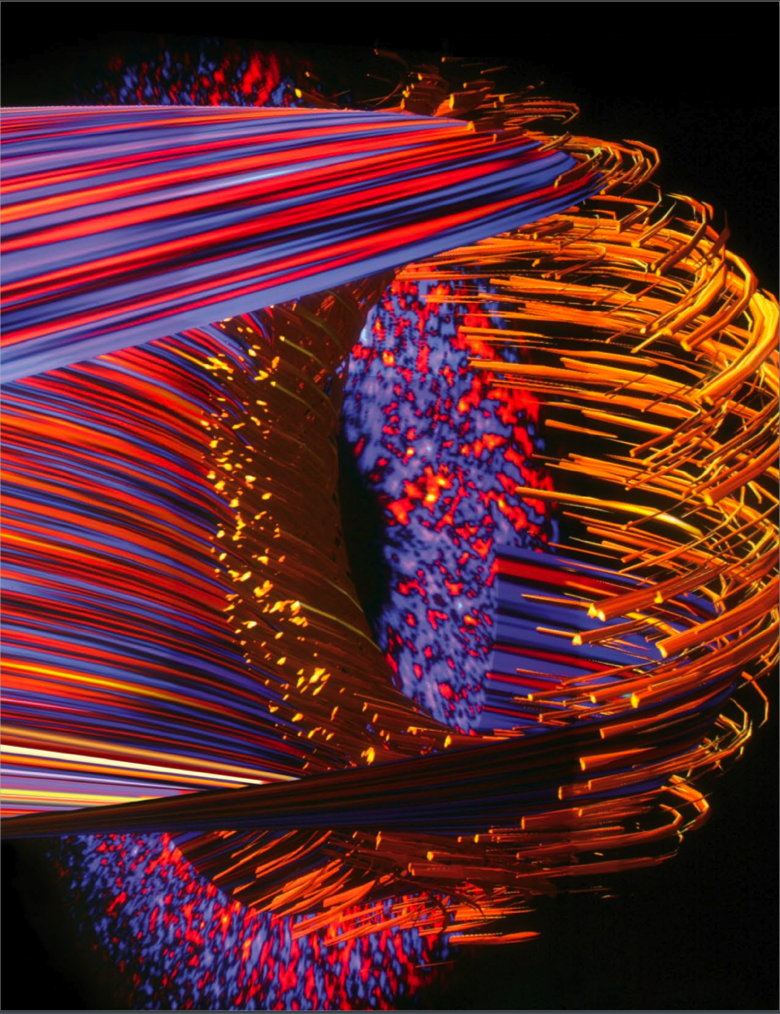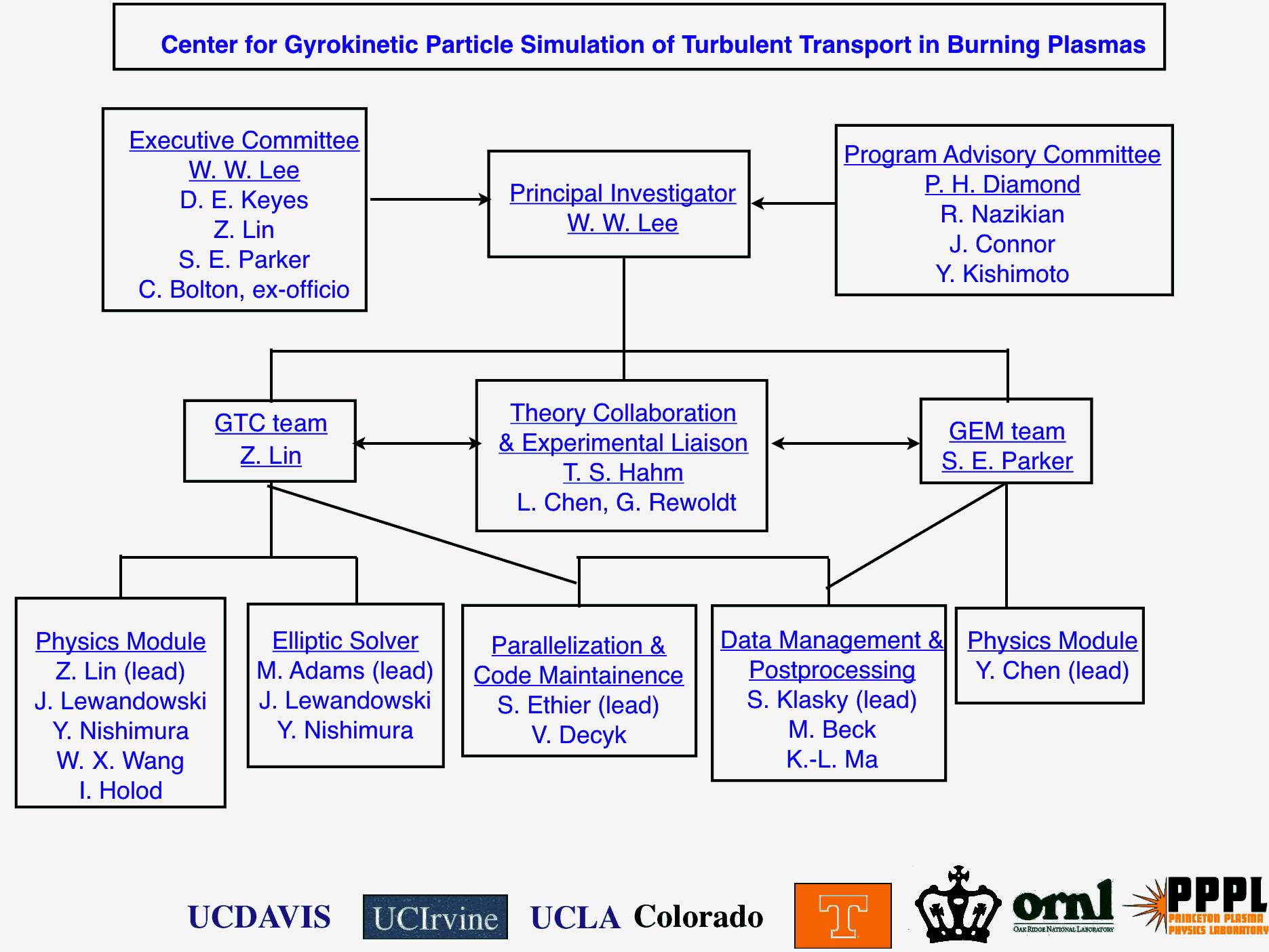|
Center for Gyrokinetic Particle Simulation of Turbulent Transport in Burning Plasmas (for FY2005 - FY2007) Note: This SciDAC Center is now in process of recompetition by a new team headed by P. Diamond (UCSD), for FY2008 on.
[A twisted mesh structure is used in the shaped GTC simulation] [Figure featured on cover of Battelle Annual Report - 2006] PI's | About the Center | Organizational Chart | Activities
Dr. W. W. Lee, Princeton Plasma Physics Laboratory, Princeton, NJ Prof. S. E. Parker, University of Colorado, Boulder, CO Prof. Z. Lin, University of California, Irvine. CA Dr. V. K. Decyk, University of California, Los Angeles, CA
SAPP PI's Prof. D. E. Keyes, Columbia University, New York, NY Prof. M. Beck, University of Tennessee, Knoxville, TN Prof. K.-L. Ma, University of California, Davis, CA Dr. S. Klasky, Princeton Plasma Physics Laboratory, Princeton, NJ
The "Center for Gyrokinetic Particle Simulation for Turbulent Transport in Burning Plasmas" has recently been selected by the Department of Energy's program of "Scientific Discovery through Advanced Computing (SciDAC) – Advanced Simulation of Fusion Plasmas". Dr. W. W. Lee of the Princeton Plasma Physics Laboratory (PPPL) at Princeton University is the head of this new national center, which includes strong collaborations with Columbia University, University of Colorado, University of Tennessee, and the University of California campuses at Irvine, Los Angeles, and Davis. It is a program that brings together leading experts in plasma simulation, theory, and computational sciences to address the grand scientific challenge of achieving better understanding of turbulent transport in fusion plasmas for: 1) the parameter regimes relevant to magnetic fusion experiments such as the International Tokamak Experimental Reactor (ITER), and 2) to lay the groundwork for an integrated fusion simulation project in the future.
Significant progress in gyrokinetic particle simulation of turbulent transport has been made since the SciDAC Plasma Microturbulence Project (PMP) was launched nearly three years. For example, effective utilization of the full power of the fastest unclassified supercomputers has enabled first-principles kinetic simulation of the electrostatic ion temperature gradient (ITG) drift turbulence in a reactor-scale plasma using our global gyrokinetic toroidal code (GTC), and the development of advanced algorithms has made possible the implementation of the electron dynamics in the PMP codes. Nonetheless, many fundamental issues in turbulent transport remain unresolved and the extrapolation of plasma confinement properties of existing experiments to the parameter regimes for burning plasmas is not fully justified. At present, none of the existing gyrokinetic (particle-in-cell or continuum) turbulence simulation codes in the fusion programs around the world can, as yet, address adequately and efficiently the scientific challenges critical to the success of a burning plasma experiment.
The present project will further develop the state-of-the-art capabilities based on particle-in-cell simulation techniques; i.e., a global code (GTC) complemented by an electromagnetic flux-tube code (GEM). The GTC code has been optimized to achieve high efficiency on a single computing node and nearly perfect scalability on both massively parallel computers (MPP) such as the IBM SP at the National Energy Research Supercomputing Center (NERSC) and parallel vector computers such as the Earth Simulator Computer (ESC) in Japan. Because of its excellent performance and scalability, GTC has been selected as the fusion code in the NERSC benchmark suite for assessing performance on advanced computational platforms, including the ESC and the CRAY X1 at ORNL. At present, it is the only US fusion code that has actually been used for benchmarking on the Earth Simulator Computer. The scientific challenges the Center faces are far beyond the usual domain of "plasma microturbulence." Our research would bring together coupled physics processes, which occur on disparate spatial and temporal scales (microturbulence vs. MHD, local vs. global) and in distinctly different regions (core vs. edge) in a fusion reactor. This work-scope addresses a crucial step toward an integrated fusion simulation project in the future.
In order to accelerate progress in a timely and cost-effective way, the basic approach advocated in the original charter for DOE’s SciDAC Program is an excellent fit for the present project. Specifically, a multi-disciplinary collaboration involving advanced simulations, analytic theories, experimental comparisons, applied mathematics, and computer sciences is necessary to tackle the extraordinary complexity of plasma turbulence. The Co-PIs of this proposal have all been actively engaged in productive collaborations with both theorists and experimentalists for formulating physics models, interpreting simulation results, and guiding experimental measurements. The simulation code validation will proceed at three levels: 1) code-code benchmarking; 2) rigorous simulation-analytic theory cross-checks; and 3) simulation-experimental comparisons with predictive capabilities. The comparisons between the existing global particle codes such as GTC, GT3D (Japan) and LORB5 (Switzerland) have been an ongoing and productive process.
Motivated by the fact that the computational grand challenge of simulating plasma turbulence inevitably pushes the limits for both the computing hardware and software, the SciDAC Co-PIs of this project have actively engaged in the applied math and computer sciences community. The capability of the massively parallel turbulence simulation codes and the ability to extract physics from large datasets will be greatly enhanced by effectively leveraging the expertise and resources from leading applied mathematicians and computer scientists. Accordingly, our Co-PIs in the Scientific Application Partnership Program (SAPP) are leading experts in applied mathematics, visualization, and data management. Their participation will undoubtedly keep this project at the forefront of fusion research.
At the 2004 APS/DPP meeting, two invited papers, which are expected to have significant influence on future directions in research on plasma turbulence, will be presented by members from the Center. The talks will focus on new results obtained from applications of the Global Gyrokinetic Toroidal Code (GTC) on the IBM SP Seaborg computer at the National Energy Research Supercomputing Center (NERSC) in Berkeley, California. Prof. Z. Lin [paper NI1.003] of UC Irvine will address a subject of very active current interest -- the question of whether electron temperature gradient (ETG) driven turbulence can contribute strongly to the anomalously large levels of transport observed in toroidal plasma experiments. Recent results from applications of the GTC code together with newly-developed nonlinear gyrokinetic theory indicate that the ETG instability saturates at low levels via a nonlinear toroidal coupling. As illustrated in the figure,
it is found that while the lengths of the extended eddy structures ("streamers"), which characterize the ETG turbulence, scale with the device size, the actual radial distance of the electron excursions is found to be much smaller and diffusive. Both the fluctuation intensity and associated transport level are thus independent of the size of the streamers. When compared to earlier radially-local ("flux tube") simulation results, the present finding is that the electron heat conductivity from ETG turbulence is much smaller and is therefore not likely to be responsible for the large anomalous electron thermal transport in toroidal devices. Dr. W. W. Lee [paper FI1B.003] of PPPL will report on important recent results dealing with the physics of steady state transport produced from the ion temperature gradient (ITG) driven instabilities. The key finding here is that appropriate treatment of the parallel acceleration dynamics produces much faster access to the steady state of the ITG turbulence when compared with conventional simulations. These more careful studies now include the velocity space nonlinearity, which apparently acts in concert with the zonal flow in the evolution of steady state turbulence. The resulting perturbed potentials for the case without the parallel velocity space nonlinearity is on the left and that with the nonlinearity is on the right.
Talks | Meetings | Exchanges | Publications | Links | Other
PSACI PAC 2007 Oral Talk - W.W. Lee
(PDF) The third GPSC meeting associated with the 2006 APS Meeting took place in Philadelphia, PA, and here is the agenda. The second semi-annual meeting associated with the 2006 Sherwood conference was held in Dallas, Texas on April 21, 2006. An agenda is available here. The second GPSC meeting associated with the annual APS meeting took place in Denver, CO and here is the speaker's list. The first semi-annual meeting took place the week of February 21, 2005 in Irvine, CA. Prof. Zhihong Lin of UC-Irvine was the local Chairman. The meeting consisted of one day of tutorial talks, two days of contributed talks and two days of working sessions, with nearly fifty people in attendance. Click here for the meeting agenda. The first get-together for the GPS center took place during the APS/DPP meeting on Wednesday, Nov. 17, 2004 from 5:00 - 7:00 pm
at
Dr. Viktor Decyk of UCLA visited PPPL from 2/2 - 2/3/05 to discuss team-coding with PPPL's members of the GPS Center. Dr. Yasutaro Nishimura, visited PPPL from 10/24/04 to 11/5/04 to work with with Mark Adams and others in the GPSC/PPPL group. Publication list for FY2005-FY2007 (currently 67 publications): GPSC Bibliography (2004 - 2007) (PDF) Selected publications:
Phys. Plasmas 2007 paper - Y. Nishimura et al (PDF) For additional U.C.-Irvine papers go to: UCI Plasma TheoryLinks
GPSC/UCI Theory Homepage
Other New Insight for Plasma Turbulence (Virtual Pressroom for 2004 APS/DPP Conference)
This website is maintained by Jennifer Jones. |
|




